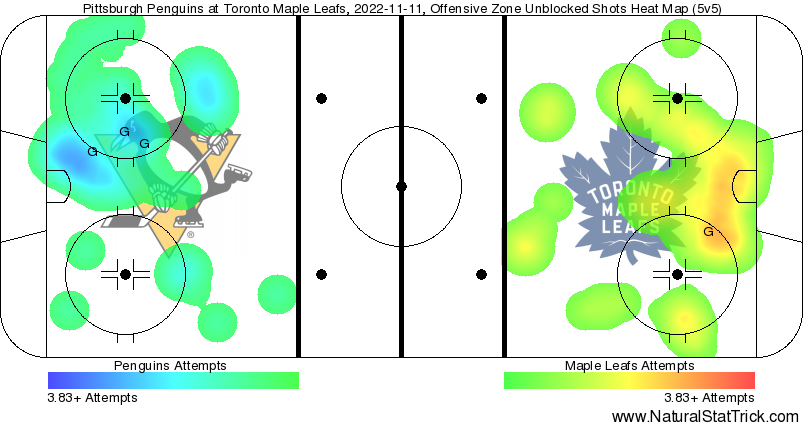Before we get into the game, let’s take a moment to recognize Börje Salming.
What a powerful ovation and moment it was to see him standing arm-in-arm alongside Darryl Sittler and Mats Sundin. There can’t have been a dry eye in the house.
Börje 💙 pic.twitter.com/XNG34beQXb
— Toronto Maple Leafs (@MapleLeafs) November 12, 2022
As for the game itself, it was up and down and ended with a whimper. The Leafs were outplayed in the first. They played with their hair on fire in the second. They generated nothing in the third, ultimately losing on a weak game-winning goal past Erik Källgren.
Your game in 10:
1. After giving up a number of odd-man rushes against Vegas — a few resulting in goals — I am sure it was a major talking point for the Leafs between games. As such, it was disappointing to see them give up an early 2v1 just a couple of shifts into the game.
Calle Jarnkrok and Pierre Engvall were both watching the play instead of looking to cover Justin Holl pinching. Even with Michael Bunting also covering, they were outnumbered. The puck was chipped by Bunting, sending the Penguins on a 2v1.
Halfway through the period, Jason Zucker went on a mini 2v1, too. The Leafs had a few power plays in the first period — Evgeni Malkin was undisciplined a couple of times — and they created chances in that time. At 5v5, though, the Penguins were creating almost at will — Natural Stat Trick recorded the scoring chances as 9-3 in their favour.
2. If you are a Leafs fan, there are few greater certainties in this life than an ex-Leafs returning to Toronto and scoring against them. It was pretty written in stone at this point. The examples are countless, but the Penguins didn’t dress any former Leafs tonight. Kasperi Kapanen was a healthy scratch (for the second straight game, no less). For once, the shoe was on the other foot.
Zach Aston-Reese, playing against his former team, scored the 1-0 goal for the Leafs. The shift was really all thanks to Denis Malgin, which is something we seem to be saying more and more often lately. He created the turnover on the forecheck, made a play with the puck, put it on net, and Aston-Reese simply swatted a rebound that happened to go in the net. Either way, it’s nice for the Leafs to be on the other side of one of these.
On his next shift, ZAR had a big hit and forecheck. He was energized by it.
3. The Penguins didn’t deserve to be losing after 20 minutes, and at the end of the first, they got a lucky bounce they deserved in the middle of a dominant shift where the Leafs had the puck on their sticks multiple times — including Auston Matthews and Mitch Marner — but continually gave it away.
The Leafs’ situational hockey has been really poor this season, which is something Sheldon Keefe has alluded to regularly. It’s the final minute of the period with the team leading 1-0 at home. They have to be able to take the lead into the intermission.
The goal itself was a bit flukey, sure; it was a point shot that deflected to a wide-open Malkin, who simply had to shoot it into an empty net. But the Penguins dominated the shift, which is when good things tend to happen for a team.
4. The story of odd-man rushes and neutral-zone transition continued early in the second for the Leafs. There wasn’t much to the lead-up here. Marcus Pettersson simply cleared the zone after fumbling the puck by putting it off the wall. It got by William Nylander and then Justin Holl seemed to think he had more time than he did when he stepped up.
Malkin chipped it by Holl before chasing the puck along the boards. Instead of TJ Brodie retreating and covering off the pass, he stepped over and challenged Malkin along the wall. Had Brodie not gone down to block a potential pass, you might’ve wondered if he knew anyone was behind him. There was nobody else on the other side of the ice except Jason Zucker, and while Malkin is getting old, he’s still Evgeni Malkin. All he needed to do was get the puck across the ice. It’s easy to say from the couch, but Brodie didn’t need to challenge Malkin from a non-dangerous spot over at the boards.
Zucker simply hammered the puck home. You can’t really fault Erik Källgren for either of the first two goals.
5. After the Penguins scored to take the lead, the Leafs turned it on and made a huge push to tie the game. The “fourth” line generated another great shift, and Denis Malgin just missed whacking a bouncing puck into an open net. John Tavares made a great cut in and found a streaking William Nylander, who was poke-checked late before Tavares got robbed on the follow-up shot.
A few shifts later, Morgan Rielly joined the rush and got a good shot off from the top of the circle. Nick Robertson then had a chance in the slot that Casey DeSmith made another good save on. The urgency definitely cranked up. They just couldn’t finish.
6. As much as the Penguins deserved one in the first to tie it up, the Leafs definitely deserved to tie it back up at 2-2. They just kept coming before the puck eventually went in.
On a power play — created by yet another scoring chance — William Nylander should have scored earlier on it when he faked Casey DeSmith out with a Jason Spezza-like shot freeze play, but he hit the post. On the next opportunity, though, he made no mistake hammering home an absolute bomb of a one-timer.
We talked about Nylander in the one-timer spot for years, and this goal was an example of why. He owns a great one-timer. He can lean in on it and it explodes off of his stick. It should be noted that Morgan Rielly‘s great fake one-timer pass back to Nylander set it up, too. He fooled everyone, and Nylander did the rest.
Some serious Will power 💪 pic.twitter.com/QrS3D8wExA
— Toronto Maple Leafs (@MapleLeafs) November 12, 2022
7. The Leafs started the game with Alex Kerfoot on the top line, but by the time the opening faceoff for the third period rolled around, it was Michael Bunting playing alongside Auston Matthews and Mitch Marner. They dominated the first shift of the period and easily could have scored multiple times. Unfortunately, they didn’t, and a few shifts afterward, the Penguins scored a frustrating goal on a few levels.
It started with the turnover in the neutral zone by Denis Malgin. It was a tight play, but you can’t turn the puck over in the neutral zone because you tried to put the puck between a player’s legs. That’s simply not NHL hockey.
After the turnover, Mark Giordano was caught flat-footed and Brock McGinn put a shot through his legs that also went through Erik Källgren. It was a bad goal for the goalie to give up. There isn’t much to say there.
We all know Källgren is only playing this much out of necessity — and he’s generally done a valiant job — but that was a bad goal to give up. A bad goal created by a bad turnover.
8. With the Leafs trailing, they shook up the defense pairings: Rasmus Sandin paired up with Morgan Rielly and Mark Giordano paired up with Timothy Liljegren. It was the return of a defense pairing that worked well for the Leafs next season (Giordano – Liljegren) and an attempt to shake it up to drive some offense.
The first and third lines swapped Michael Bunting and Alex Kerfoot. The second and fourth lines stayed the same, which might be a good sign for Nick Robertson. He has aspects to work on to round out his game, but he can score and is dangerous with the puck on his stick.
Keefe followed the original line shakeup by loading up the top line completely and playing William Nylander on the left side alongside Mitch Marner and Auston Matthews. Malgin was then promoted to play with John Tavares and Robertson (who still remained on that second line).
The Leafs were 25th in total 5v5 goals going into this game. They have really struggled to score goals at evens so far this season. It appears it’s getting to the coaching staff finally as this is the most line juggling I can ever recall under Sheldon Keefe.
9. After all the line shuffling, the trio that created the most dangerous shift was Michael Bunting – David Kampf – Calle Jarnkrok. The recipe was pretty simple: they won battles to keep the puck in the offensive zone, and the whole five-man unit kept throwing pucks toward the net. Eventually, the puck worked its way to Jarnkrok, who got a decent one-timer off from the fringes of the slot.
When Pittsburgh eventually cleared the zone, the puck went to the Leafs’ blue line and both teams were changing. For some reason, TJ Brodie tried to rush a far-side outlet pass to Rasmus Sandin as if he had a potential breakaway when he did not. The Penguins were right there, and even if the pass was completed, Sandin had no support and no options.
Even worse, it resulted in an icing and killed even more clock on the Leafs; plus, they couldn’t change lines (even though Matthews managed to sneak on anyway). The Leafs eventually did load up a unit with the goalie pulled, but they created nothing. The Penguins should have scored on the empty net at least three times before they did. The Leafs put a total of four shots on net in the third period.
10. Noteworthy ice-time figures: Pierre Engvall was effectively benched and played just 7:49. At his best right now, he is taking empty-calorie shifts. At his worst, he’s turning it over. The next lowest Leaf was 10:52 (Nick Robertson), by the way, so it wasn’t as if Engvall’s entire line went down with him.
Mitch Marner played 24:28. Auston Matthews played 23:45. Matthews and Marner have been generally productive this season — hovering around a point per game each (Matthews just under now, Marner just over) — but they aren’t lighting the world on fire. After the first shift in the third period, they were barely noticeable, but it seems they keep getting trotted out there together no matter what happens.
On the other side, Evgeni Malkin increased his point total to 67 points in 41 career games against the Leafs. He just dominates them every single time.
Heat Map: 5v5 Shot Attempts

Game Flow: 5v5 Shot Attempts





















![Two Down, Two to Go for the Maple Leafs – MLHS Podcast EP91 [Now with Video]](https://mapleleafshotstove.com/wp-content/uploads/2025/04/maxresdefault-3-218x150.jpg)















